Mulberries and an (a?) Herb
/3 Comments/in Fruit, Pests/by Lee ReichMulberries, Still
I finally am getting to eat some ripe mulberries this year, and they were — and are — very, very good. The wait wasn’t because the tree was too young. And anyway, mulberries are very quick to bear fruit, often the year after planting.
I got to eat fruit from my tree this year because resident birds have been kind enough to share some with me. Of course, it was not really kindness on their part. 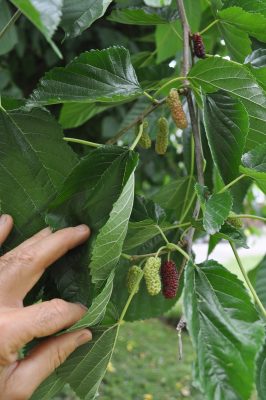 Birds also eat fruit for their juiciness, and the past weeks and weeks of abundant rainfall probably satisfied some of that need. The only other year I had plenty of mulberries — much more than this year — was a few years ago when 17-year cicadas descended upon here. All summer I awoke to their grating cacophony, but did feast on mulberries as birds feasted on the cicadas.
Birds also eat fruit for their juiciness, and the past weeks and weeks of abundant rainfall probably satisfied some of that need. The only other year I had plenty of mulberries — much more than this year — was a few years ago when 17-year cicadas descended upon here. All summer I awoke to their grating cacophony, but did feast on mulberries as birds feasted on the cicadas.
You might think it late in the season for mulberry fruits, which started ripening back in early July, to still be ripening. The variety name of my tree says it all: Illinois Everbearing. Not only is this variety everbearing, but it also has a very fine flavor, much better than the run-of-the-mill and ubiquitous wild mulberries whose fruit is usually too cloying. Illinois Everbearing’s sweetness is balanced with a bit of refreshing tartness.
Good as it is, Illinois Everbearing’s fruits cannot compare with that of black mulberry. The “black” refers to the species, Morus nigra. Illinois Everbearing is a hybrid of our native red mulberry, M. rubra, and white mulberry, M. alba, an Asian species that was introduced into our country about 200 years ago, liked it here, and mated with the native species. Black mulberry can only be grown in Mediterranean climates, so mine, in a large pot, bears only a handful of berries each year.
Some people contend that black mulberries adaptability is more widespread than mild winter climates. I have my doubts but I am going to graft a branch from my little tree onto some stems of some wild mulberries and see what happens. (The wild mulberries might either be white or red mulberries, or natural hybrids of the two; the color designations have nothing to do with the color of fruit a tree bears.)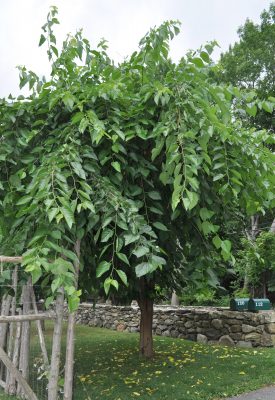
I’m happy enough with the long season, good flavor, and occasional harvest of Illinois Everbearing. Plus, it’s a pretty tree, and large, so the branches are now beyond reach of deer, who love to eat mulberry leaves.
I devote a whole chapter to mulberries, white, red, and black, in my book Uncommon Fruits for Every Garden.
Basil, Uh Oh
Bringing my eyes down from the dark mulberries to ground level, and walking over to the vegetable garden, I take a close look at this year’s basil. Hmm. Very slight yellowing of some of the leaves. Could it be . . . ? Yes, turning over one of those slightly chlorotic leaves I see tell-tale purplish brown spores, indicating downy mildew disease.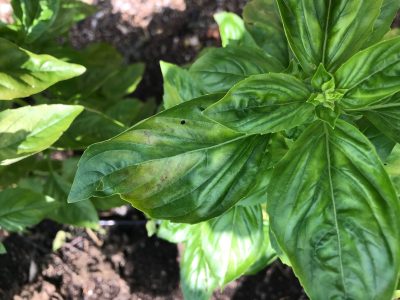
A relative newcomer to the garden scene, basil downy mildew (a different pathogen than cucumber downy mildew, grape downy mildew, etc.) arrived on the East Coast in 2007, made it to the West Coast by 2009, and to Hawaii by 2011. It hitchhike around on infected seed, infected plants, and infected leaves.
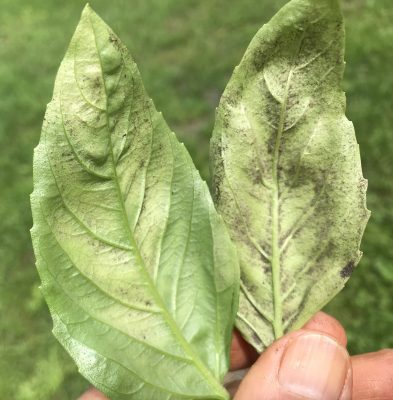
Basil downy mildew, leaf underside
Some organic fungicides are allowed for controlling the scourge, but my basil mingles so intimately with other plants in the vegetable garden that I don’t consider that an option. Fortunately, other controls are feasible.
One thing would be to not mingle my basil so intimately with other plants. Sunlight is one nemesis of the mildew, as with most fungi. Better air circulation would also lower the humidity around the plants and speed drying of the foliage, also not to the liking of the mildew fungi.
Going one step further, Dr. Meg McGrath of Cornell University suggests growing basil in pots. Plants can be whisked under cover on cool nights, when dew threatens, or during rain or cloudy conditions.
Starting off with clean seed or plants would also limit infection. Not totally, though. Although the fungus does not overwinter in cold regions, given good (for the fungus) conditions, it can hitchhike up here over hundreds of miles.
Breeders are hard at work developing resistant varieties of basil, with some success. Among the resistant varieties are Amazel (shouldn’t the name be Amasil or Amazil?), Eleanor, Emma, Everleaf (Basil Pesto Party), Devotion, Obsession, and Thunderstruck. I’m growing Amazel and Everleaf this year. No sign of mildew on Amazel. Everleaf, this year, at least, has it as bad as my standard varieties.
None of the resistant mentioned varieties are immune to basil downy mildew, just resistant. So it pays to also give the plants a lot of sunlight and good air circulation, and consider pitted plants, for their mobility.
And Some Entomo . . . No, Etymology
Fun herb fact: The word “herb” was borrowed from the old French word erbe, which is why we don’t — and the British didn’t, initially — pronounce the h. Scribes in the 15th century, influenced by their knowledge of Latin, started using the Latin word herba. But still, no one spoke the h. Fast forward to the mid-19th-century and, all of a sudden, dropping h’s became a marker of low social class among the Brits, so they dropped them.
Summer Love
/12 Comments/in Vegetables/by Lee ReichHow Do I . . . er, Can Thee?
With apologies to E. B. Browning: “How do I store [as in ‘preserve’] thee? Let me count the ways. I store thee to the depth and breadth and height a Mason jar can reach . . . “ And in other ways.
Red, ripe tomatoes, the essence of summer. How to capture that essence for a dark, snowy winter day? A few ways: Let me count the ways.
Canning tomatoes can be a complicated, drawn out process, or something quick and easy. In the heat of summer, I choose the latter, merely filling a large pot a half-inch of water and then whole tomatoes from which any diseased or unripened areas have been excised.  No de-skinning, de-seeding, or chopping. The pot is allowed to cool a bit after its volume has been reduced to one-half to two-thirds of the original volume.
No de-skinning, de-seeding, or chopping. The pot is allowed to cool a bit after its volume has been reduced to one-half to two-thirds of the original volume.
Less than a minute with my immersion blender then homogenizes the works, readying the mix for canning jars that have been scrubbed clean — except for one more critical addition to each jar: 2 tablespoons of bottled lemon juice or 1⁄2 teaspoon of citric acid per quart of tomatoes. The reason for the lemon juice or citric acid is to make the mix more acidic. And the reason to make the mix more acidic is to prevent growth of the bacterium Clostridium botulinum which, you might guess from the name, causes botulism.
Tomatoes vary in their acidity. I actually bought a pH tester to test the acidity before adding the lemon juice or citric acid. The tomatoes tested at pH of 4.2. But tomatoes differ in their acidity, depending on variety (paste tomatoes are generally less acidic) and growing conditions; perhaps the next batch would not make the cut. So, just to make sure . . .
Next, canning lids are put in a small pot and covered with water which was just brought to a boil. I fish out a lid with a pair of tongs and lay it in place atop a jar, then screw it down secure with the jar’s metal ring. The rings need to be tightened just enough to seat each lid against the glass but not so tight as to prevent escape of gases when the jar is heated, the next step.
I use a pressure canner, which speeds processing because less time is needed at the higher temperatures that can be achieved under pressure. Fifteen minutes at 10 pounds (which puts the temperature at 240°F) does the job. Forty-five minutes would be needed when canning with a boiling water bath, and that doesn’t include the time needed to get enough water boiling to be able to submerge all the jars.
I carefully remove jars after their allotted time and let them cool. 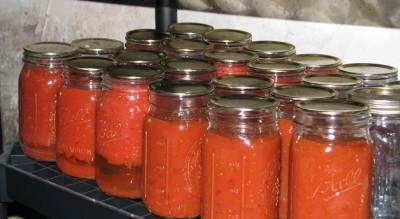 Once cool, pressing down on the the center of each lid lets me know whether that jar has sealed well. The lid should not move down when pressed.
Once cool, pressing down on the the center of each lid lets me know whether that jar has sealed well. The lid should not move down when pressed.
Rich and Saucy
I failed to mention one more step early in my canning process, and that is the sorting out the San Marzano tomatoes. This variety makes the best-tasting sauce so we segregate it for single variety canning. In Italy, tomatoes canned with San Marzano variety tomatoes are specifically labelled as such. So are ours.
How Do I . . . er, Dry Thee?
As I wrote, with the help of E. B. Browning, “Let me count the ways,” plural.
Years ago I pooh-poohed a friend’s suggestion to dry tomatoes, probably because he said eating them was “fun.” Then I tried drying some. They weren’t fun too eat but they sure taste good in winter, their intense flavor released as they are crumbled on salads or soaked in water and cooked with other vegetables. Not good on pizza, though; they burn.
Slices a quarter of an inch thick are good for drying. Layed on stacked trays in my dehydrator, with the temperature set at 130°F, the slices dry to leathery or brittle, depending on the ambient humidity, overnight.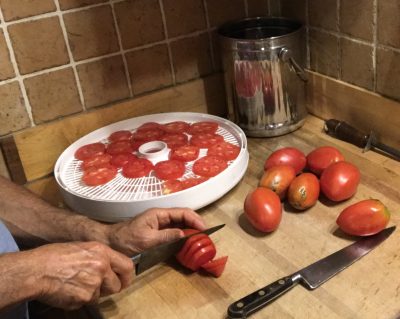
Once dry, the slices are packed into canning jars with the lids screwed down tightly to prevent air from entering.
How Do I . . . er, Freeze Thee?
I haven’t yet finished “counting the ways.” One more way: freezing. All that’s needed is to cut any bad spots from the fruit and put them into a freezer bag.
The frozen tomatoes add yet another tomato-y flavor and texture for winter. To me, they’re more like fresh tomatoes than either the canned or the dried ones. Fresh-cooked, of course, not fresh raw. Fresh cooked or frozen fresh, cooked, lends a different flavor and texture than canned.
Just popping the fresh fruit into the freezer is also a way to preserve peppers. To me, though, the taste of frozen peppers are a far cry from the fresh summer ones no matter how they are used. But then, ripe, red peppers are one of my favorite garden vegetables, so the bar is high for them in any other form.
Plants I Like
/1 Comment/in Flowers/by Lee ReichFrom Ancient Egypt
King Tut is alive and well, very well in fact. I’ll cut to the chase: This particular King Tut is a variety of papyrus (Cyperus papyrus) that I planted a year ago in spring. Papyrus doesn’t tolerate temperatures down to freezing, so this far north King Tut is billed as an annual. But rather than let the King die in winter, I was so smitten by him that in autumn I moved him in his pot indoors to a sunny window. There he clung to life and, with warm, sunny weather, got growing again this past spring.
In contrast to regular papyrus, which grows 5 to 9 feet tall, King Tut’s claim to fame is that he’s a dwarf, billed as rising 4 to 6 feet high. My King Tut only gets about 3 feet high. 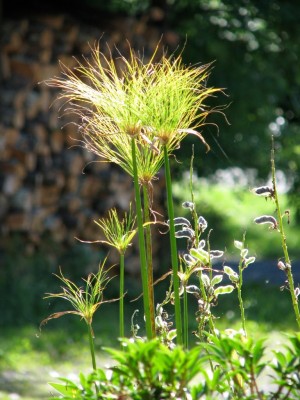 All papyrus have a very distinctive and attractive appearance. The base of the plant is a clump of grassy leaves from which rise tall, leafless stalks which are capped by grassy-leaved mopheads looking something like the ribs of an umbrella. A houseplant relative of papyrus, Cyperus alternifolius, is commonly called umbrella plant.
All papyrus have a very distinctive and attractive appearance. The base of the plant is a clump of grassy leaves from which rise tall, leafless stalks which are capped by grassy-leaved mopheads looking something like the ribs of an umbrella. A houseplant relative of papyrus, Cyperus alternifolius, is commonly called umbrella plant.
Many, if not most, problems with plants in general can be attributed to too much or too little water. King Tut (and umbrella plant) are very easy to grow because they love water up around their ankles. All the plant needs is a deep saucer in which the pot can sit, with the saucer kept full of water. Not that King Tut demands water around his ankles. It’s just that consistently moist soil is needed, which means close attention to watering or standing in a water-filled saucer.
King Tut grows very rapidly, so this spring I divided the one King Tut plant into two and potted each one up separately. I also cut back all the old stalks. Although I tossed them in the compost pile, I could have made them into sandals, a boat, paper, or any one of the other papyrus products of ancient Egypt.
A Nice Weed
A few weeds garner my respect and my affection. Over the past few weeks, spotted spurge (Euphorbia maculate) has become one such weed. Spotted spurge has mouse-ear sized leaves, each with a reddish blotch along part of its main vein, and the leaves line up in a very orderly manner along the stems. 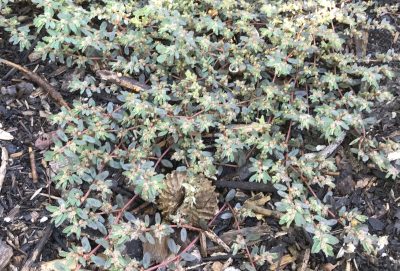 The definitive identifier for this weed is the way the stems spread out, flat, on top of the ground. In sun, no part of the plant rises more than a half an inch above ground level.
The definitive identifier for this weed is the way the stems spread out, flat, on top of the ground. In sun, no part of the plant rises more than a half an inch above ground level.
Mostly, I see spotted spurge growing in the wood-chip mulched paths in my vegetable garden. The amazing thing about this plant is the way it keeps sprouting in the paths. Even during the dry weeks of last June, spotted spurge kept sprouting. Not that it doesn’t also turn up following recent rains and in the irrigated, planted beds. I can’t help but respect a plant that can keep showing up under such adverse conditions.
Whenever I see the flattened stems, I reach down and pull it out, roots and all. My affection for this plant comes from the ease with which it is removed. The stems don’t form roots where they touch ground, as many other plants do, so grabbing the center of the clump gets rid of a square foot of weeds in one fell swoop. How satisfying.
Removing the plants is important. Spotted spurge is a summer annual that thrives in heat. Left alone, tiny flowers in each leaf axil give rise to tiny seeds that germinate through summer or, when weather warms, next year. It’s important not to dawdle in removing the plants because only a couple of weeks of growth are needed before young plants are old enough to flower and make seeds.
From Cosmos
I’m not usually a big fan of flower breeders’ new and wondrous creations, such as blue roses or tulips that look like peonies or peonies that look like tulips. That said, I’m quite enthralled with some cosmos I planted this spring that have been bred to look not very cosmo-ish.
What I’ve always liked about cosmos is their lack of pretension. The flowers are simple and sit singly atop tall stalks of sparse but feathery leaves. So along comes cosmos Rose Bon Bon. 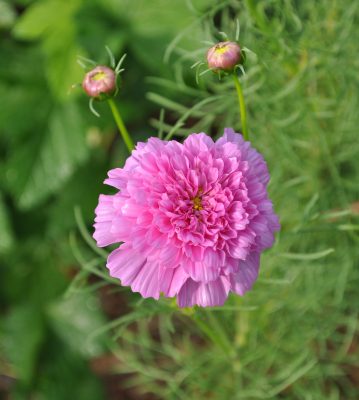 As a cosmos fan, I figured I’d try Rose Bon Bon in spite of the fact that the flowers are double, which means they have multiple rows of petals. More complex and, hence, less cosmo-ish.
As a cosmos fan, I figured I’d try Rose Bon Bon in spite of the fact that the flowers are double, which means they have multiple rows of petals. More complex and, hence, less cosmo-ish.
Rose Bon Bon flowers, all of them soft pink, are beautiful. They’re still cheery, just like regular cosmos, frilly and cheery in this case. The name Rose Bon Bon notwithstanding, they do NOT look like roses.

